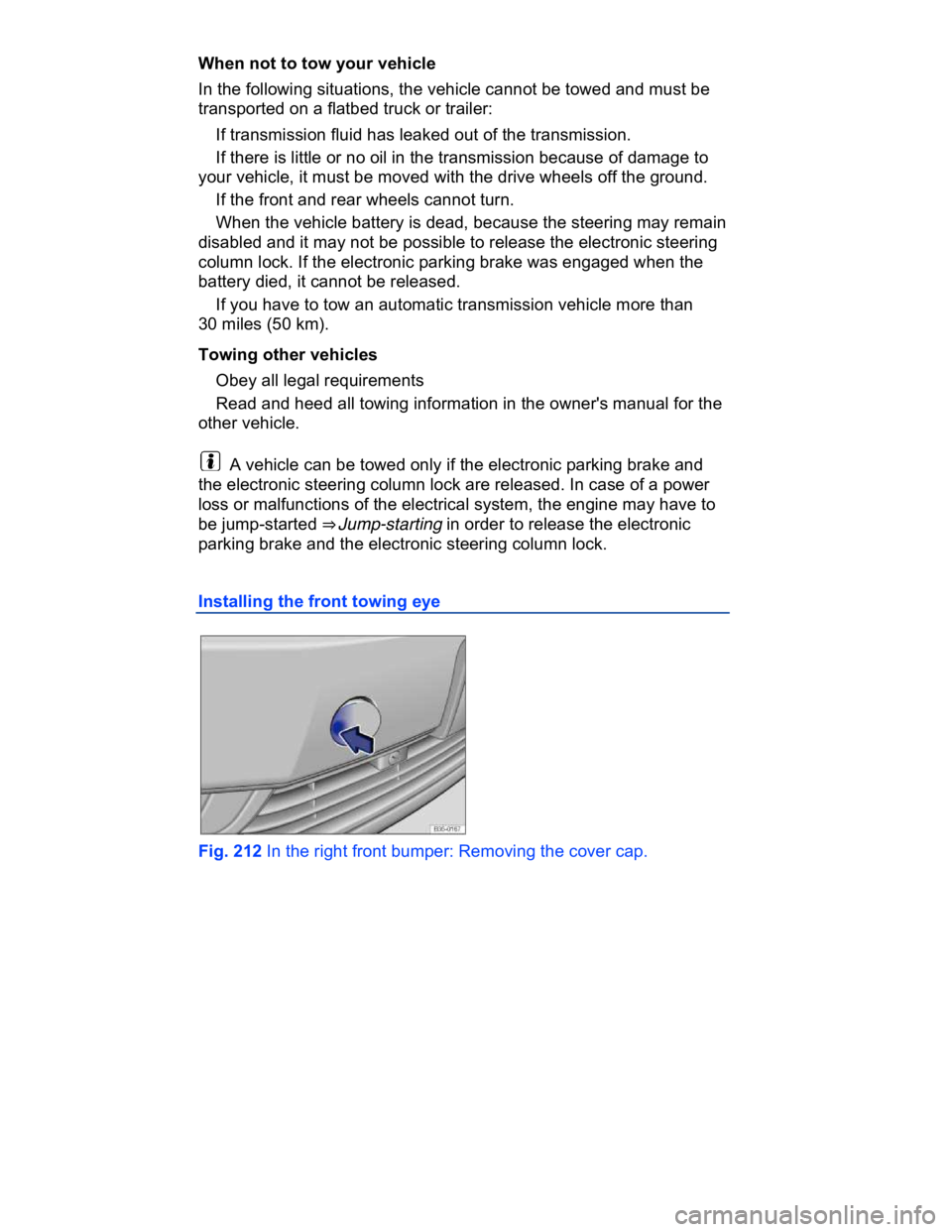Page 563 of 578

jump-start terminal6 ⇒ Positive jump start terminal, 3.6 liter engine,
⇒ fig. 210 (+).
3. Attach one end of the red jumper cable to the positive terminal (+)
of the dead battery: (1) ⇒ .
4. Attach the other end of the red jumper cable to the positive termi-
nal (+) of the good battery (booster battery): (2).
5. Attach one end of the black jumper cable to the negative terminal
(-) of the booster battery: (2) ⇒ fig. 211.
6. Attach the other end of the black jumper cable (3) to a bare metal
part of the vehicle with the dead battery. This part should be
connected directly to the engine block. You may also attach the
cable to the engine block itself. Attach the clamp to a point that is
as far away as possible from the dead battery (1) ⇒ .
7. Route the jumper cables so that they cannot get caught in any
moving parts in the engine compartment of either vehicle.
Starting the engine
� Start the engine of the vehicle with the good battery that is provid-
ing help and let it run at idle speed.
� Turn on the ignition of the vehicle with the dead battery. If the en-
gine starts, wait 2 to 3 minutes until it “runs smoothly” before remov-
ing the jumper cables as described below ⇒ . If the engine does not
start within about 10 seconds, turn off the ignition and wait at least
1 minute; then try again.
Before removing the jumper cables
� Switch off the headlights (if they are on).
� In the vehicle with the dead battery, switch on the heater fan and
the rear window defroster. This helps to minimize voltage spikes
when the cables are disconnected.
Removing jumper cables
With the engine running, remove the jumper cables in reverse order
to the way they were connected.
1. Disconnect the black (-) cable from the vehicle with the dead bat-
tery.
6 For vehicles without a battery in the engine compartment, see ⇒ page 587, Positive jump start terminal, 3.6 liter engine
Page 564 of 578
2. Disconnect the black (-) cable from the other vehicle (vehicle with
the good battery).
3. Disconnect the red (+) cable from the other vehicle (vehicle with the
good battery).
4. Disconnect the red (+) cable from the vehicle with the dead battery.
5. Close the battery cover or snap shut the cap on the positive jump-
start terminal6, as the case may be.
6. If necessary, unscrew the towing eye on the front of the vehicle ⇒
Installing the front towing eye.
Page 565 of 578

WARNING
Improper use of jumper cables when jump-starting a vehicle
with a dead battery can cause the battery to explode, leading to
serious personal injury. To help reduce the risk of battery ex-
plosion:
� All work on the batteries or the electrical system in your ve-
hicle can cause serious acid burns, fires, or electrical shocks.
Always read and heed the following WARNINGS and safety pre-
cautions before working on the batteries or the electrical sys-
tem ⇒ Vehicle battery.
� Always wear proper eye protection. Never lean over the vehi-
cle battery.
� Attach the jumper cables in the correct order: first the posi-
tive cable, then the negative cable.
� Never connect the negative cable from the vehicle providing
starting assistance to parts of the fuel system or to the brake
hoses or brake lines.
� Never allow the non-insulated parts of the battery clamps to
touch.
� Never allow the jumper cable attached to the positive battery
terminal to contact metal parts of the vehicle.
� Check the battery acid level indicator window on the vehicle
battery. Use a flashlight, never a match, cigarette lighter, or
other open flame. If you cannot see the color of the window
clearly, or if it is light yellow or colorless, do not jump-start the
vehicle. Get expert assistance.
� Avoid electrostatic discharge in the vicinity of the vehicle
battery. Sparks may cause the hydrogen gas escaping from the
vehicle battery to ignite.
� Never jump-start a vehicle with a battery that is damaged or
frozen or that was frozen and has thawed. The battery can ex-
plode. Replace the battery instead.
� Always follow the instructions of the jumper cable manufac-
turer.
� Always make sure that the battery providing starting assis-
tance has the same voltage as the dead battery (12 V) and
about the same capacity (see battery label).
Page 566 of 578
� Batteries give off explosive hydrogen gas. Always keep fire,
sparks, open flame and smoking materials away from batteries.
� Never connect the negative cable from the other vehicle di-
rectly to the negative terminal of the dead battery. The hydro-
gen gas from the battery is explosive.
� Never short out the battery terminals by connecting the posi-
tive (+) and negative (-) terminals with each other.
Page 570 of 578
electrical system is operating. In the following situations, the vehicle
cannot be towed at all and must be transported on a flatbed truck or
trailer:
� If the front and rear wheels cannot turn.
� If the vehicle battery is dead (because the electronic steering col-
umn lock engages and cannot be released).
� If you have to tow an automatic transmission vehicle more than
30 miles (50 km).
WARNING
It is not safe for children or other persons to ride in a vehicle
that is being towed.
� Never let children or anyone else remain in the vehicle while
it is being towed.
NOTICE
The drive axle rotates while the vehicle is being towed with its
rear wheels off the ground. This can damage the automatic
transmission.
� Never tow automatic transmission vehicle with the rear wheels
off the ground.
� Tow manual transmission vehicles with the rear wheels off the
ground only if it is certain that no transmission fluid can leak
out.
Tips on towing
�
Page 572 of 578

When not to tow your vehicle
In the following situations, the vehicle cannot be towed and must be
transported on a flatbed truck or trailer:
� If transmission fluid has leaked out of the transmission.
� If there is little or no oil in the transmission because of damage to
your vehicle, it must be moved with the drive wheels off the ground.
� If the front and rear wheels cannot turn.
� When the vehicle battery is dead, because the steering may remain
disabled and it may not be possible to release the electronic steering
column lock. If the electronic parking brake was engaged when the
battery died, it cannot be released.
� If you have to tow an automatic transmission vehicle more than
30 miles (50 km).
Towing other vehicles
� Obey all legal requirements
� Read and heed all towing information in the owner's manual for the
other vehicle.
A vehicle can be towed only if the electronic parking brake and
the electronic steering column lock are released. In case of a power
loss or malfunctions of the electrical system, the engine may have to
be jump-started ⇒ Jump-starting in order to release the electronic
parking brake and the electronic steering column lock.
Installing the front towing eye
Fig. 212 In the right front bumper: Removing the cover cap.